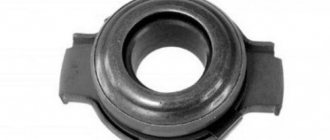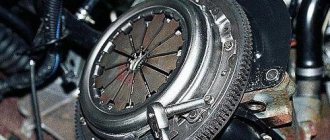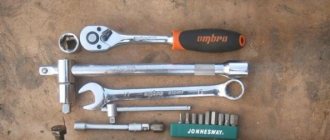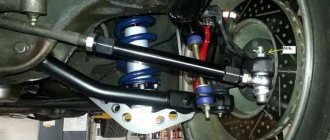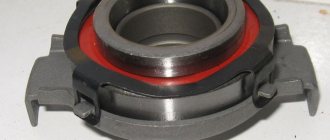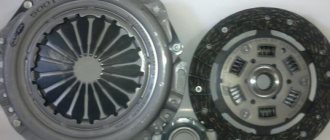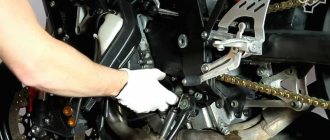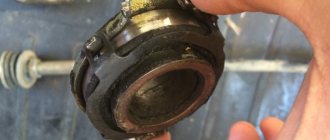Where does noise come from when a car's clutch operates?
Using the example of the clutch of VAZ 2108, 2109, 21099 cars, we will try to figure out where the noise came from when the clutch was operating and what ways there are to solve this problem.
Clutch noise when engine is idling
If you listen, from the clutch and gearbox side, while the car engine is idling, you can hear a continuous, distinct noise. When you depress the clutch pedal, the noise disappears or noticeably decreases.
Such signs may indicate a failure of the gearbox input shaft bearing on which the clutch basket and driven disc are “mounted”. The shaft begins to “dangle” together with the broken bearing, making noise, and when the clutch is disengaged, the load on it is reduced and the noise disappears. This malfunction is often accompanied by oil leakage from the gearbox under the input shaft oil seal. In the early stages, the malfunction is practically unnoticeable, but as the bearing deteriorates, it makes itself known.
The release bearing can also make noise and even howl at idle, since its working surface is always pressed against the leaf pressure spring of the basket and rotates with it (the clutch on the VAZ 2108, 2109, 21099 is backlash-free). A bearing malfunction may be a consequence of lubricant leaking out of it, after which a play appears and it will begin to make sounds when its moving part rotates. See photo at the beginning of the article.
To determine what exactly is noisy at idle - the releaser or the shaft bearing, we will do the following.
Disconnect the cable from the clutch release fork. We start the engine and leave it idling. Then turn the fork slightly clockwise. The release bearing will come out of contact with the clutch pressure diaphragm spring and the sound should disappear. The howling has disappeared - the release valve is faulty and needs to be replaced. If it does not disappear, you will have to remove the box and replace the input shaft bearing, or replace the oil in it with a better or thicker one.
Noise when disengaging the clutch
If a howling sound is heard from the clutch housing when you press the pedal, then the release bearing has most likely failed. We release the pedal, the noise disappears or decreases. If the bearing jams or is completely jammed, then it will not be possible to press (disengage) the clutch normally. The engine will stall, and it will become almost impossible to “stick” the gear.
Also, when you press the pedal, the clutch may make noise if its drive is not adjusted correctly. It “drives” - the driven disk does not completely move away from the flywheel when turned off, it rubs against it and makes noise. The malfunction can be eliminated by adjusting the drive.
Noise when engaging clutch
When the driver releases the clutch pedal, turning it on, a distinct noise or even rattling, metallic ringing and knocking is heard from the gearbox and clutch.
This indicates wear or breakage of the driven disk (wear, deformation, loosening of its linings, breakage of damper springs) or loosening of the gearbox to the engine.
Notes and additions
— On VAZ 2108, 2109, 21099 cars, the clutch is constantly engaged, that is, the input shaft of the gearbox rotates together with the clutch basket and driven disk. See “Design and principle of operation of the clutch of VAZ 2108, 2109, 21099 cars.” When you press the pedal, the release bearing comes into operation, which presses on the pressure spring of the basket, forcing its drive disk to move away from the driven one.
— The operation and serviceability of the clutch can be fully assessed by carrying out a comprehensive check. See “Checking the clutch on VAZ 2108, 2109, 21099”.
Where is it used?
Automakers use this element on systems with two disks - slave and master. The first element receives torque from the second and transmits it to the transmission. Further, through the cardan transmission, the force is transmitted to the gearbox, and then to the wheels. The drive disc is tightly secured to the crankshaft. In order for the driver to move from one gear to another (no matter whether it is high or low), it is necessary to separate these two elements. This operation is carried out precisely thanks to the bearing. The force is controlled by pressing the clutch pedal. When it is pressed to the floor, the transmission of torque stops - the bearing rotates at the same speed as the flywheel. As it is released, the two disks are connected to each other. At this time, high loads are observed on the clutch release bearing. Malfunctions of these elements arise precisely because of heavy loads.
Clutch slipping after replacing all its parts
After replacing all elements, adjustment is required, but many car owners ignore this point. The cause is slipping, the car accelerates slowly, the engine speed does not correspond to the speed of the car. The engine just roars, and the car is driving quite slowly, as they say, slipping.
In cars with a mechanical clutch cable, adjustment is made by the cable itself. In hydraulically driven machines, this process is carried out using a clutch rod. In modern cars, you often come across rods that do not have adjustments. But this does not mean at all that it cannot be produced. In such cases, adjustment of the clutch pedal itself is provided, but not everyone knows about this possibility.
The machine often slips due to wear on the flywheel surface in the place where the surface works in tandem with the driven disk. The mistake of many car owners is that they first of all change the disk, while completely forgetting about the flywheel. As a result, you have to disassemble the car twice to fix the problem.
How to determine its wear?
First of all, the element will begin to make characteristic noises and sounds. And what’s most interesting is that they are impossible to notice while driving in gear. But as soon as you press the clutch pedal, a terrible hum occurs, and sometimes a knocking sound. It is especially intensified in winter. It is worth noting the high reliability of the design of such a part as the clutch release bearing. It is very difficult to notice signs of a malfunction of this unit in the early stages. Sometimes a slight rustling will be heard, which does not intensify over time. However, this sign is quite enough to diagnose the element for malfunction. Difficulties also arise when engaging gears, especially reverse. Turning on the speed may be accompanied by a characteristic crunching sound. Also, this symptom may indicate a malfunction of the synchronizers or the pressure and driven disk. But in any case, when noise appears, it is necessary to diagnose all components of the assembly.
Signs of malfunctioning parts
The release clutch can fail not only due to improper use, but also due to natural wear and tear. Knowing the operating principle of the device, you can determine its technical condition based on its characteristic symptoms. Typical symptoms of a malfunction are:
- The occurrence of extraneous noise when pressing the clutch pedal. The destruction of the node is accompanied by a grinding or loud crunch.
- Gear shift drive sticking. Sometimes it is impossible to turn on the desired speed.
- Excessively free play of the clutch pedal.
- Incomplete engagement or disengagement of the clutch. The situation may be accompanied by an unpleasant burning smell.
Additional signs of a breakdown are: increased fuel consumption, engine overheating, and jerky movement of the vehicle. The service life of the part is reduced due to dust and dirt getting into the bearing, increased temperature and lack of lubrication.
Signs of a defect cannot be ignored, because... This can lead to serious consequences when driving with a faulty transmission.
Control check
You can diagnose the condition of the squeezing device in the following way:
- Start the car engine. Listen to your work for any extraneous noise. If available, determine the location.
- Depress the clutch pedal. If an extraneous sound appears, the part will need to be replaced.
The bearing cannot be repaired. The problem is solved by replacing the defective part.
Consequences of malfunction
The element has sufficient strength, so it cannot fall apart instantly. However, there is no point in delaying the elimination of the defect, since failure leads to misalignment of the disks and uneven wear. As a result, problems will arise with the transmission, which will negatively affect the technical condition of the vehicle.
If the part falls apart, the driver will not be able to engage the desired gear and move away. If such a defect occurs while the vehicle is moving in the city, the services of a tow truck will be required.
Why does noise appear in the gearbox on a Lada Kalina - when you squeeze the clutch, the noise disappears
Car : Lada Kalina. Asks : Makar. The essence of the question : the problem is noise in the clutch, what should I do?
When starting the car when it is cold, a noise is noticeable. As it warms up the noise disappears. But if you immediately depress the clutch pedal, the noise disappears. What is this? I'm afraid that I might get in the way. They told me it was a release.
This is especially noticeable on a cold engine.
The problem is relevant not only for Kalin, but also for the tenth family, Prior, Grant.
If after replacing the clutch the car jerks
For example, before the repair, the car did not pick up speed well, it was slipping, and the clutch pedal was activated at the very top. All the signs of a worn driven disc were present. After replacing the disk, the car began to jerk. What could happen after the repairs were carried out?
- The issue may be a defective part. This is not so rare when it comes to non-original spare parts. In Russian-made cars (VAZ, GAZ, AZLK, IZH), defects also occur in factory parts. That is, the driven disk is simply curved. On the clutch basket (drive disc), the pressure petals may be at different levels, then the release occurs unevenly and the car jerks.
- The car may jerk due to clutch adjustment. More precisely, it was not performed after replacing the disk. The linings of the new part are much thicker; in this case, the clutch pedal “takes at the very end”. When starting off, the car moves jerkily, and the gear shifts into gear with a crunch.
- The car jerks due to the replacement of not all the parts that needed it. In particular, the cause of jerking is the worn surface of the flywheel under the driven disk. If the flywheel has not been replaced, there may be jerking when driving, and the car may also slip.
For what reasons does a release bearing fail?
Engaging the gear plus holding the clutch for a long time most often leads to premature destruction of the release bearing. By making such a mistake in traffic jams, you thus expose the bearing to heavy loads, which shorten its service life. It is worth noting that breakdowns in the clutch system most often plague beginners who have only recently gotten behind the wheel and have not yet learned how to properly operate the car.
There is a misconception among drivers; many people think that the release bearing rotates only when the car is moving. This is not at all true; when the clutch is depressed, a torque drive is supplied to the cage. Parts wear out quickly precisely because the clutch is not used correctly.
There are two types of clutch bearings:
- Ball (roller), consisting of mechanical units that transmit force to the bearing thanks to a rigid bunch of rods. This design is also the most common;
- Hydraulic - differ from ball bearings in the presence of hydraulics, which makes it easier to depress the clutch pedal.
Replacing the release bearing of Priora
In order to change the part, you will have to remove the gearbox. You can find detailed instructions for removing the gearbox here (link to page).
After removing the box, you need the following:
The first step to removing the bearing is to find the antennae of a special spring retainer. Next, we remove the two ends of the antennae from the bearing holder. To do this, you need to apply a little force and pull the antennae out of the two holes. Now the bearing together with the holder can be easily removed from the guide sleeve. In order to inspect or replace the part itself, you will need to remove it directly from the holder
To do this, use a flat-head screwdriver to press out the four metal tabs in several places on the case. Now the part can be removed and replaced with a new one. When installing a new bearing, pay attention to its visual condition (there should be no defects or cracks). After installation and lubrication, unscrew the part while checking its operation for any extraneous noise.
In addition, no noticeable backlash should be recorded. Reinstalling the gearbox.
Now you know how to change the release bearing on a Priora!
Important points
Please note that there are counterfeit auto parts on sale today. Please note that most new, original release valves contain light-colored factory-applied lubricant.
In addition to the above, we recommend that you purchase release levers that are made only of metal. In addition to the presence of a metal body, make sure that in the places of fastenings, the so-called lugs (clamps), the metal coating is of a uniform color without signs of hardening at high temperatures. Pay special attention to checking the part for the so-called backlash (should be absent or minimal). Rotate the product, listen to see if there is any noise when it rotates.
In order to choose a Priora clutch release bearing, you need to know what clutch system you have installed (which manufacturer). For example, Valeo also has its own, original bearings that are not interchangeable. And on the contrary, it guarantees full compatibility and correct operation with various clutch systems on Kalina and Priora cars. Plus, there are good reviews about the quality and long service life.
How to extend the service life
To ensure that the clutch system lasts as long as possible, we recommend that you do not depress the pedal for a long period of time. In other words, if you don't plan to change gear in the next 1-2 seconds, don't press the pedal. Thus, you will significantly reduce the load on the system and increase its service life.
Lada Granta release bearing is noisy
During operation of LADA vehicles, a howling or humming noise from the gearbox may occur. Information letter No. 11-14 contains recommendations for diagnosing noise in the input shaft bearing of LADA vehicles. It shows an algorithm that can be used to gradually isolate noise from the general noise of a car in various modes.
| No. | Vehicle operating mode | Driver actions | Result | Conclusion |
| 1 |
a) the engine and gearbox are not “warm up”
b) the engine and gearbox are “warm up”
a) the engine and gearbox are not “warm up”
b) the engine and gearbox are “warm up”
a) the engine and gearbox are not “warm up”
b) the engine and gearbox are “warm up”
By the way, in some cases, the reasons for the howling and hum of the gearbox may lie on the surface, and you can get rid of it by simply modifying the clutch cable.
Let us remind you that AvtoVAZ also has a method for identifying the causes of vibrations and jerks when starting a LADA car.
- ✅ Contents of the article:
- 1. Signs of a malfunctioning clutch release bearing on Kalina
- 2. Dismantling the gearbox and removing the release clutch
- 3. Installing a new release bearing
- 4. Replacing the bearing without removing the box
- 5. How to choose a “squeezer”: number, dimensions, price
- 6. Repair tips and useful videos
The release bearing (VP) is a ball bearing that is installed in a special clutch with a spring and moves along the input shaft bushing. The part is used to press the clutch disc and remove the flywheel from engagement with the gearbox.
The release bearing (Kalina VAZ 1118, Priora, Granta), like the clutch, periodically fails after a long mileage or improper operation and maintenance. If a clutch malfunction occurs, the gearbox will need to be removed for repairs, but there is a method in which the Kalina release bearing is replaced without dismantling the gearbox .
Many VAZ 1118 owners often ask the question “How much does it cost to replace a release bearing on a Kalina?”, we can say with confidence that in a car service this repair will cost about 3,000 rubles. Replacing it yourself according to these instructions will take you 3-4 hours, so the choice is yours.
The article outlines a guide to replacing the clutch release bearing on a Lada Kalina with removing the gearbox, and also shows a method without removing it. Additionally, information is provided on the selection of spare parts, numbers, prices, and sizes. The material is accompanied by numerous photographs, as well as supporting videos, including on replacing the clutch on Kalina. This instruction is suitable for owners of Lada Priora, Lada Granta, VAZ 2110-2115 cars.
Troubleshooting methods
Data-lazy-type=”image” data-src=”https://vazremont.com/wp-content/uploads/2017/11/foto-7-1.jpg” alt=”Gearbox repair” width=” 496″ height=”280″ class=”lazy lazy-hidden size-full wp-image-4366″ srcset=”” data-srcset=”https://vazremont.com/wp-content/uploads/2017/11/ foto-7-1..jpg 300w" sizes="(max-width: 496px) 100vw, 496px">
- If all the gears in the VAZ 2114 gearbox are lost, this means that the problem lies in the bearings. If the breakdown is not repaired in time, repairs will cost even more.
- Noise after starting the engine. The cause of the malfunction also lies in the bearing (drive shaft) or lack of transmission oil.
- The noise disappears after changing gears. The trouble lies in the synchronizer clutch. It is possible that there are problems with the locking mechanism.
- It is not possible to disengage the clutch completely. The “culprit” is the same drive shaft bearing.
Good for those carefree drivers who belong to the category of “riders”. They don't care what happens in the car. It makes noise, crackles, howls, whines - the main thing for riders is that the car is moving. And they ride on their “victims” until death.
But a normal vehicle owner pays attention to every squeak in their favorite vehicle. Therefore, upon hearing the noise that the gearbox makes, the driver begins to get nervous and look for the cause.
If he himself is not a professional, he naturally turns to a car service center. There they console him: “It’s okay. Let’s change the release bearing and everything will be back to normal!” Well, you can understand the repairmen too. Drivers are dummies, and according to service technicians, they exist so that the profession of an auto repairman will be prestigious. (In the monetary sense.) But, if you look at it soberly...
Even if you are a person of a humanitarian mindset, you should have enough sense to try to determine for yourself whether it is worth going to the mercy of prestigious auto repair shops or whether it will be a waste of money.
To begin with, you can try to disconnect the cable that goes from the pedal to the clutch fork, and move the fork itself towards the generator. Start the engine. If the noise persists, then most likely it is produced by the support bearings located at the rear of the primary and secondary shafts. If you change regular engine oil to a thicker one - such as GL-4 or GL-4/GL-5 - the extraneous sound may well disappear. And if it hasn’t disappeared, but you are confident that the diagnosis was made correctly, you can spit on this noise. In the sense that it does not affect anything other than your hearing.
Another reason for the sound that irritates the driver may be the clutch disc itself - if there is play in the central clutch of the disc, with which it sits on the input shaft. The damper springs of the driven disk can also play.
The release bearing, by the way, can indeed also make noise due to play coupled with the clutch release guide sleeve.
If the rubbing teeth of the gears and the input shaft in your car have worn out - this could be due to natural old age, or from your manner of jumping off a la a Hollywood stuntman - here you go, another reason for the noise of the gearbox.
It often happens that this extraneous noise appears for a very simple reason - the inattention or negligence of the driver. It is necessary to regularly check the oil level in the box. If the oil is “driving” somewhere, then noises may arise – and very quickly – for all of the above reasons.
And if the driver stops paying attention to the noise of the gearbox, then such a ride can end very badly - the gearbox will simply jam. It’s good if this happens without consequences - such as a traffic accident - and in the city
Imagine that you put your entire blessed family in the car - right down to the cat and mother-in-law - and drove out of town for a picnic with barbecue and badmintons. And already at a considerable distance from civilization, the above-predicted blunder will occur with the gearbox. It will be a sad story...
Let's start with the fact that one of the most common transmission-related problems is. This problem is well known to many owners of cars with, and quite often a vehicle with a humming gearbox is quite suitable for further use.
In other words, if a manual transmission is humming, but the unit itself is working normally, the gearbox is often used for quite a long time without repair. As for, in this case the appearance of automatic transmission hum and noise is a more serious problem.
Read in this article
Design, adjustment, configuration and replacement of the Lada Priora clutch
The content of the article:
Lada clutch device
From "Murzilka". The connection is made through a special ratchet mechanism that regulates the length of the cable. Therefore, during the operation of the vehicle, it is not necessary to regularly check and adjust the working stroke of the clutch pedal. This mechanism also ensures that there is no play in the clutch release drive.
During operation, the driven disk linings wear out. To compensate for this wear, an automatic cable length adjustment mechanism is built into the clutch release drive. As the linings wear, the clutch release fork lever turns and tightens the cable. At the same time, the spring located in the bushing of the adjustment mechanism is compressed and tightens the clamps of the toothed tip of the cable. The clamps release the tip, as a result of which it is freely pulled out of the cable leader, compensating for wear on the disc linings.
If the driven disk linings are not worn out, then when the pedal is released, the bushing only touches the bracket and does not release the clamps - the toothed tip of the cable does not move relative to the body. As the linings wear, the clutch release fork lever with the threaded end of the cable moves forward (in the direction of the vehicle), tensioning the cable. In this case, the spacer sleeve, resting against the bracket, releases the spring-loaded clamps and the toothed tip of the cable moves out of the housing by the amount necessary to compensate for the wear of the linings.
After installing the cable, we adjust the clutch drive. To do this, pull the cable forward by the threaded end until it stops, overcoming the force of the spring, and hold the cable in this position. Using a caliper we measure the distance from the end of the plastic leash to the clutch release fork lever, which should be 27 mm. If necessary, rotate the leash to achieve the required distance. When removing the load (releasing the cable), the leash should adhere to the fork lever without play. After this, press the clutch pedal three times to activate the automatic cable length adjustment mechanism. We check the full travel of the clutch pedal, which should not exceed 146 mm.
Adjusting the clutch of Lada Priora
It started to smell like the clutch periodically. I decided to tighten it up, opened the Murzilka and was surprised that it was so easy to do this on a Priora. I waited until the weekend, took a regular screwdriver and a ruler.
Turn off the mass air flow sensor and remove the air filter.
We see a cable and a plastic clip at the end.
We pull this clamp towards ourselves,
measure how many mm from the end of the plastic clamp to the plug (should be 27mm). I had 15mm.
We twist this clamp counterclockwise,
thereby increasing the size from plug to clamp. We measure, it should be 27mm, if so, then release the cable and put it in the fork. We get into the car, press the clutch 3 times, go back and look, measure how much it has become, if everything is the same 25-27mm, then everything is done, if more or less, we adjust further. In the end, we put everything back together, start it, and check it. Personally, the smell immediately disappeared for me, which means the clutch will still live.
Replacing the clutch in Lada Priora
2 months ago the clutch began to act up (it became harder to press, some clicks appeared when pressed) and the release bearing began to rattle. While I was driving, I thought it would pass, but the clutch release rattled louder and louder, and the clutch began to work even worse. I consulted with friends, they said go buy a new clutch, your release lever will soon fall apart, and it’s better to change the entire clutch right away, since there are many difficulties. I went to the store and consulted with the salesman about which clutch was best to buy, the salesman advised to take the KRAFT or VIS company, but said that they charge more for KRAFT than VIS, so I had to take KRAFT, the price is 1800 rubles. Just 3 weeks ago the clutch disappeared and the speed stopped turning on. I immediately drove it into my uncle’s garage and slowly began to disassemble everything with him.
If there is a knocking noise after replacing the clutch
As a rule, the cause of knocking after replacing parts is defective parts. In particular, there are dangling damper springs in the driven disk. Therefore, before installing such a spare part on a car, you need to carefully inspect it. Parts of the disk may also be poorly riveted.
Knocks in the clutch area can occur due to a crack in the release bearing bushing (the bushings are often made of plastic). Even at the site where the bushing fits on the flange of the gearbox input shaft, play may form, which also leads to a knocking sound.
The knocking noise occurs due to a broken clutch basket petal, but such a defect occurs infrequently. Another reason for the knocking is a broken starter housing in the Bendix area; it rattles when the car moves. A tooth on the flywheel crown may break off, and it will also knock when touching the rotating parts.
Vibration that occurs after replacing clutch elements
There are few reasons why vibration occurs after replacing a clutch. Vibration usually appears in two forms:
- The pressure plate (clutch basket) is not balanced;
- During assembly, the driveshaft was installed in a different position from the original installation (but this only applies to rear-wheel drive or all-wheel drive vehicles).
By and large, on cars with front-wheel drive, you can inaccurately secure the wheel drive (CV joint), and the movement of the car will be accompanied by vibration and knocking, but this does not happen often.
If the clutch basket creates vibration, you can try moving it to a different position. As a rule, the pressure plate mounts are symmetrical. On many models, the basket is attached to the flywheel with six bolts, and the basket can be placed in three positions. In one position the vibration may disappear completely or be minimal. But it is better to exchange the warranty part immediately for another one. This will be less hassle for the car owner.
Oil: maybe this is the reason?
There are several reasons why a transmission starts to howl. The first, most common, is the oil level in the box. Many motorists do not attach importance to the need to monitor the oil level in the gearbox. This leads to oil starvation mainly in the fifth gear, which is higher than the rest. Due to the lack of oil, the bearings begin to overheat and fail. This is accompanied by a high-pitched howl that occurs when driving in fifth gear. This disease is treated by overfilling 100 - 200 grams of gear oil above the level with constant monitoring.
Some may say that overfilling the oil will cause it to leak through the seal joints. To prevent this from happening, you must first clean the breather, and secondly, pour oil in parts, gradually. For example, at first 100 grams, and after a while, if there is no leakage, so much more. You can also add a second oil seal to the gearbox rocker.
The next, no less common reason for the sound of the gearbox is the poor quality of the gear oil poured into the gearbox or incorrectly selected. If we talk about domestic cars, then, for example, the use of oil of the APIGL-5 category in the gearbox of front-wheel drive VAZs leads to rapid wear of the synchronizers, which will cause gearbox noise when switching. Therefore, it is mandatory to use an APIGL-4 class transmission. Domestic oils of this classification are quite difficult to find, so you have to use lubricants from foreign manufacturers. But their use can significantly extend the life of the gearbox, avoiding various sounds when driving.
In addition, insufficient or excessive viscosity of the oil used also affects the wear of box parts and the presence of sound during its operation. For example, very thick oil with a viscosity of 85W-90 creates a strong film, protecting gears from wear, but at the same time it makes it difficult for lubricant to reach some gearbox parts, which may suffer from oil starvation, causing premature failure. It will also be difficult to change gears due to the need for synchronizers to squeeze out excess oil, which again will lead to rapid wear of parts. The first sign of very thick oil will be the presence of howling when cold and its disappearance when the unit is warm.
Change of oil
Too thin an oil will cause the opposite effect, in which the oil film will break off when hot, accelerating the wear of gearbox parts, which will again be accompanied by howling and humming.
You should be extremely careful when choosing gear oil according to the recommendations of the manufacturer and experienced servicemen.
Clutch faults Lada Kalina
Long-term use leaves its mark on the clutch mechanism; the driven disc linings wear out and become thinner. In order to compensate for this wear, the ratchet mechanism, as we have already said, automatically compensates for the degree of wear and tightens the cable. This is done by turning the release fork, causing the spring, which is located in the bushing of the adjustment mechanism, to compress. The spring, in turn, compresses the clamps of the toothed tip of the cable, after which the tip is released and tightens the cable.
The noise of the Lada Granta gearbox as a feature of the car
The mechanical transmission box of the VAZ-2181, introduced in 2012, uses a cable rather than a rigid traction drive. The cable drive provides easier gear shifting (especially 1st and 2nd gears). The disadvantage of the design is the occurrence of extraneous sounds.
Gearbox noise "Lada Granta"
According to the manufacturer, the hum appears due to poor quality processing of manual transmission gears. In 2014, plant representatives issued a statement that the problem had been fixed. The noise was reduced, but did not disappear completely. The outdated equipment used when processing gear teeth does not allow obtaining the required degrees of accuracy. To eliminate the whine of the gearbox on the Grant, a significant amount of production will need to be modernized. So far, AvtoVAZ cannot afford this.
In 2022, the transmission can be found on Grants in the body:
- sedan, hatchback, station wagon with a VAZ-11186 engine (16 valve, volume 1.6 liters);
- liftback with VAZ-21127 engine (16 valves, 1.6 l);
Also, the VAZ-2181 is installed on the “Cross” modification with the VAZ-11186 and VAZ-21127 engines and the “Drive Active” with the VAZ-21127 engine.
It is rarely possible to defeat the howl of a manual transmission on a Grant. If the driver and passengers are noisy in the cabin with a manual transmission, it is better to buy a Lada Granta with an automatic transmission or a robot. A sudden noise should alert you. The howling of the box may indicate failure of individual elements. It will be cheaper to pay for a transmission overhaul than to buy a new unit later.
Why does the brake pedal hit when braking?
The car's braking system is quite simple, and there are not many parts that can fail. Moreover, almost each of them can lead to the problem under consideration. If the brake pedal hits when braking, you need to check the following units:
- Brake pads. Severe wear on the brake pads can cause the brake pedal to squeal. It is necessary to check the pads for wear and determine their suitability. In this case, both front and rear pads should be diagnosed. If the thickness of the part does not meet the requirements of the brake system (or the pads have mechanical damage), it will need to be replaced. Do not forget that the pads must be changed in pairs on the same axis.
- Brake drum. When braking, the pads touch the drum. If it is damaged or deformed, vibration from their contact will be transmitted to the car body, including the brake pedal. Often the brake pads and brake drum on the rear axle of the car fail at the same time, and they will need to be replaced together to get rid of the problem.
- Brake discs. When operating a car, brake discs have to withstand severe loads associated not only with friction, but also with temperature changes. When driving in the city, you often need to press the brake pedal, which increases the temperature of the brake discs. If cold water (for example, snow) gets on them, they can become deformed under the influence of sudden temperature changes. A bent brake rotor will cause problems with braking and transmission of vibration into the pedal.
Please note: It is important to replace discs, like brake pads, in pairs on one axis. However, after replacing the disks, the problem may persist, even if all units are working properly. It is necessary to “break in” the new part a little so that the pads get used to it.
Brake cylinders. If the brake cylinders are deformed or malfunctioning, this can cause the brake pedal to wobble. In such a situation, it is recommended to inspect the cylinders for any distortions. If they are not detected, you need to lubricate them to be sure that there are no freezes.
It is important to inspect the entire braking system when looking for the cause of brake runout. Due to one faulty unit, other parts may become unusable.
Eliminating glass chatter in a Lada Granta car
Sometimes a car owner is faced with the problem of loose glass installation. Lada Granta glass rattling must be eliminated, and this becomes an urgent task for the car enthusiast. It happens that on large bumps the rear windows begin to drop a little, and the rattling sound becomes unpleasant.
How can you deal with rattling glass on Grant?
To eliminate glass rattling, you need to purchase a special D-shaped seal from an auto parts store. It is usually produced in a size of 8 mm. It is sold in construction stores, and the cost does not exceed 50 rubles. To seal all car windows, it is enough to have 7 m of such an accessory. You can even equip your windshield with it.
Methodology for identifying clutch noise on LADA cars
To identify the noise of the clutch release clutch on LADA Vesta, Granta, Kalina, Priora, XRAY AMT, Lada 4×4 cars, a special technique was compiled at AVTOVAZ. Specialists of LADA dealership centers refer to this instruction. The methodology was sent to the Lada.Online website by one of the site’s readers.
When assessing the malfunction of the clutch release bearing, it is necessary to take into account that at the moment all cars produced by JSC AVTOVAZ use a clutch without clearance, so the clutch release bearing is always preloaded and rotates with the engine running.
what could happen on the fret fret when the clutch is pressed there is a noise
Well, okay, let’s correct the wording: dress workers and some forum members who have joined them. Did anyone feel much better? Such? If yes, then it's definitely not him. At least if you listen from the interior, it doesn’t look like it at all. Although, perhaps, in the cabin this sound becomes dull beyond recognition? Yesterday I opened the hood - I didn’t hear anything similar to the sound from the video, no matter how hard I listened. Maybe you should have lowered the phone closer to the checkpoint, as the author of the video did. For whom is it a fact? How is it confirmed, preferably documented?
Are there any reliable statistics? If not, what are the grounds for making such unequivocal statements? If there is an opportunity here to launch a poll on the topic of whether sabzhe tapping is present, it would be interesting to look at the results. I have a classic 07 2008. there was nothing like that. It’s interesting that the topic of subject knocking is also raised on foreign car forums, and there is also no shortage of good advice like don’t worry and forget it, everyone does it.
That is, for example, KIA also forgot how to make a manual transmission - well, yes, of course, of course. I didn’t even think about the resonator, IMHO the sound is completely different, and the dependence on the pressed/released clutch pedal is unambiguous. Plausible. But in my case, if you listen from the interior, the sound does not resemble the knock of a bearing (see link to the video above). Why did you discard the version of the releaser knocking on the bushing? I just changed the clutch basket to a Valeo (it was Luk from the factory) - the knocking noise has not gone away.
